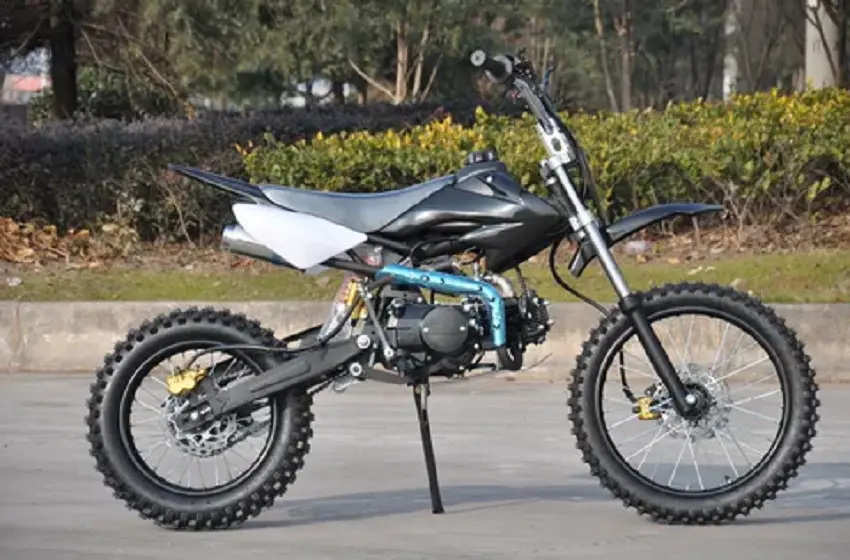In the exhilarating world of off-road motorcycling, the 125cc dirt bike stands as a testament to the perfect balance between power and agility.
These nimble machines have captured the hearts of riders across the globe, from wide-eyed beginners to seasoned professionals.
In this comprehensive guide, we’ll dive deep into the heart-pounding realm of 125cc dirt bikes, exploring their history, advantages, top models, riding techniques, and much more.
So strap on your helmet and get ready for an adventure through the dusty trails and high-flying jumps of the 125cc dirt bike universe.
What Is a 125cc Dirt Bike?
At its core, a 125cc dirt bike is a lightweight, off-road motorcycle designed to conquer unpaved terrain with ease.
The “125cc” refers to the engine displacement, which hits the sweet spot between manageable power and thrilling performance.
These bikes typically tip the scales at 150-200 pounds, making them incredibly easy to handle for riders of various sizes and skill levels.
Why They’re Popular Among Riders of All Levels
The universal appeal of 125cc dirt bikes stems from their versatility and approachability. Let’s break down why they’re beloved across the riding spectrum:
- Beginners: For those just starting their off-road journey, 125cc dirt bikes offer an ideal platform to learn proper techniques without being overwhelmed by excessive power. The forgiving nature of these bikes allows newcomers to build confidence and develop essential skills.
- Intermediate Riders: As skills progress, 125cc bikes continue to challenge and reward. They’re perfect for honing advanced techniques and pushing personal limits, offering enough power to thrill without being unmanageable.
- Advanced Riders: Even for those with years of experience, 125cc dirt bikes provide a unique riding experience. They demand precision and skill to extract maximum performance, offering a refreshing challenge that keeps advanced riders on their toes.
- Professionals: In various racing classes, 125cc bikes showcase their competitive edge. Many top-tier riders cut their teeth on these machines, proving that mastery of a 125cc can lay the groundwork for success on larger bikes.
“The 125cc dirt bike is the great equalizer. It teaches you to ride with finesse and carry momentum, skills that benefit you on any size bike.” – Ryan Dungey, 4-time AMA Supercross Champion
This quote from Ryan Dungey encapsulates why 125cc dirt bikes are so revered in the off-road community. They’re not just stepping stones to bigger bikes; they’re legitimate tools for developing championship-caliber skills.
The Rich History of 125cc Dirt Bikes
Origins in Motocross Racing
The 125cc class in motocross racing burst onto the scene in the 1970s, quickly becoming a fan favorite due to its intense competition and accessibility for younger riders.
This era saw brands like Yamaha, Suzuki, and Honda battling for supremacy, each pushing the boundaries of what was possible with a 125cc engine.
Key milestones in early 125cc motocross history:
- 1974: The AMA introduces the 125cc National Motocross Championship
- 1975: Marty Smith wins the first 125cc AMA National Championship on a Honda
- 1978: The FIM establishes the 125cc World Championship
These early years set the stage for decades of innovation and competition, cementing the 125cc class as a crucial part of the motocross world.
Evolution of Technology and Design
Over the past five decades, 125cc dirt bikes have undergone a remarkable transformation. Let’s trace the key advancements that have shaped these machines into the technological marvels they are today:
- 1970s:
- Introduction of long-travel suspension, revolutionizing off-road handling
- Shift from steel to aluminum for some frame components, reducing weight
- 1980s:
- Transition from air-cooled to liquid-cooled engines, improving performance and reliability
- Introduction of disc brakes, enhancing stopping power
- 1990s:
- Widespread adoption of aluminum frames, significantly reducing overall weight
- Refinement of suspension systems, including inverted forks for improved handling
- 2000s:
- Implementation of electronic power valves, optimizing power delivery across the rev range
- Introduction of fuel injection on some models, improving efficiency and throttle response
- 2010s-Present:
- Integration of advanced electronics, including traction control and multiple power modes
- Use of exotic materials like carbon fiber and titanium in high-end models
- Development of electric 125cc equivalents, pushing the boundaries of off-road technology
This evolution showcases the constant drive for improvement in the 125cc class. From humble beginnings to high-tech marvels, these bikes have come a long way while maintaining their core appeal.
Advantages of 125cc Dirt Bikes
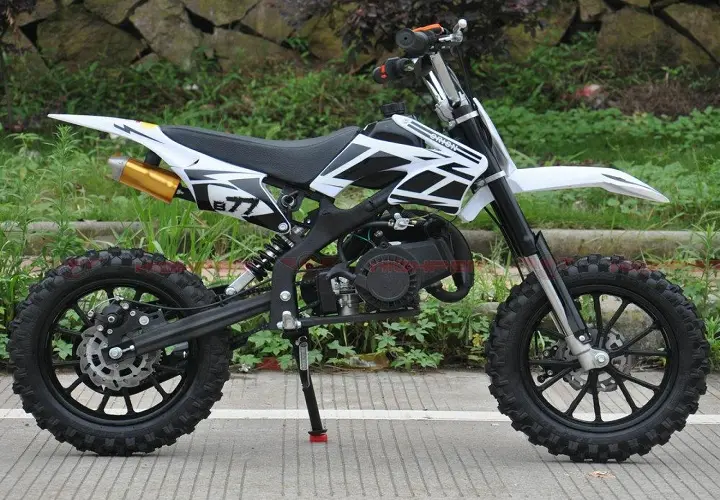
The enduring popularity of 125cc dirt bikes isn’t just about nostalgia or tradition. These machines offer a unique set of advantages that make them invaluable tools for riders of all levels. Let’s explore the key benefits that set 125cc dirt bikes apart:
Lightweight and Nimble
The low weight of 125cc dirt bikes is perhaps their most defining characteristic, typically ranging from 150-200 pounds. This featherweight nature translates to incredible agility on the trail or track:
- Quick Direction Changes: Riders can effortlessly flick the bike from side to side, essential for navigating tight trails or executing rapid line changes in races.
- Easier Maneuverability: The light weight makes it easier to control the bike in the air during jumps or to muscle through challenging terrain.
- Reduced Fatigue: Riders can manhandle these bikes for longer periods without tiring, extending ride times and enjoyment.
- Forgiving Nature: The low weight means less momentum in crashes, potentially reducing injury severity and making it easier to pick up the bike after a fall.
Excellent Power-to-Weight Ratio
Don’t let the small engine size fool you – 125cc dirt bikes pack a serious punch relative to their weight:
- Rapid Acceleration: These bikes can explode out of corners, often keeping pace with larger bikes in skilled hands.
- Impressive Top Speeds: On suitable terrain, 125cc dirt bikes can reach speeds of 55-65 mph, more than enough for thrilling off-road adventures.
- Momentum Mastery: The balance of power and weight teaches riders to maintain speed through clever line choice and body positioning, skills that translate to all levels of riding.
Ideal for Learning and Improving Skills
125cc dirt bikes offer an unparalleled platform for skill development:
- Forgiving Power Delivery: The manageable power output allows beginners to build confidence without being overwhelmed.
- Emphasis on Technique: Riders must learn to carry speed and use momentum efficiently, developing skills that pay dividends on any size bike.
- Responsive Handling: The lightweight and agile nature of these bikes provides immediate feedback, helping riders understand the consequences of their inputs.
- Broad Learning Curve: From beginners to pros, 125cc bikes continue to challenge and teach, growing with the rider’s skill level.
Versatility in Different Terrains
These adaptable machines excel in a variety of off-road environments:
- Motocross Tracks: Enough power to clear jumps and blast through whoops, with the agility to rail berms and navigate tight sections.
- Tight Woodland Trails: Narrow enough to squeeze through trees and light enough to maneuver over roots and rocks.
- Open Desert Rides: Capable of maintaining good speeds on flat terrain while still nimble enough to handle sudden obstacles.
- Rocky Mountain Paths: Light weight aids in climbing steep inclines and navigating technical descents.
This versatility makes 125cc dirt bikes excellent all-rounders, capable of tackling a wide range of off-road challenges with aplomb.
Top 125cc Dirt Bike Models for 2024
The 125cc dirt bike market is more competitive than ever, with manufacturers constantly pushing the envelope of performance and technology. Let’s take a closer look at some of the leading models available in 2024:
| Model | Weight | Power Output | Suspension | Price Range |
| Yamaha YZ125 | 194 lbs | 34 hp | KYB SSS Fork | $6,899 |
| KTM 125 SX | 187 lbs | 38 hp | WP XACT Fork | $7,599 |
| Husqvarna TC 125 | 188 lbs | 38 hp | WP XACT Fork | $7,699 |
| Beta 125 RR | 196 lbs | 35 hp | ZF Fork | $7,999 |
Yamaha YZ125
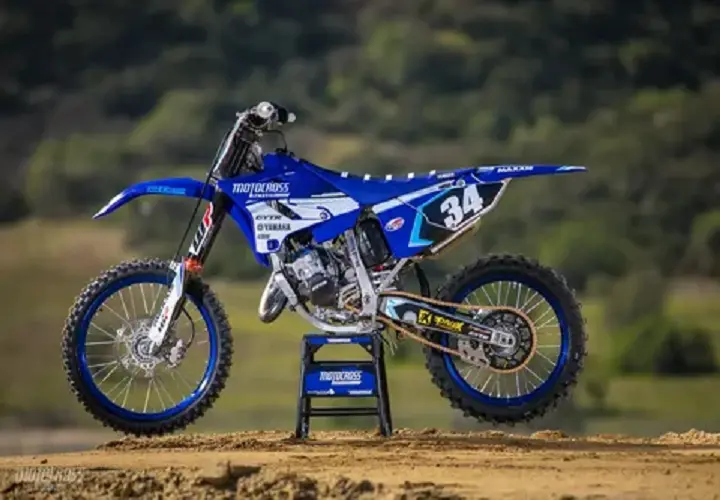
The Yamaha YZ125 has been a staple in the 125cc class for decades, and for good reason. Known for its reliability and user-friendly power delivery, it’s an excellent choice for riders transitioning from smaller bikes or those looking for a proven platform.
Key Features:
- Lightweight aluminum frame for precise handling
- Smooth, predictable power delivery ideal for building confidence
- Renowned KYB SSS (Speed Sensitive System) fork for excellent front-end feel
- Excellent cornering stability thanks to refined chassis geometry
Pros:
- Legendary reliability and build quality
- Extensive aftermarket support
- Great resale value
Cons:
- Slightly lower peak power compared to some competitors
- Carbureted engine (some riders prefer fuel injection)
KTM 125 SX
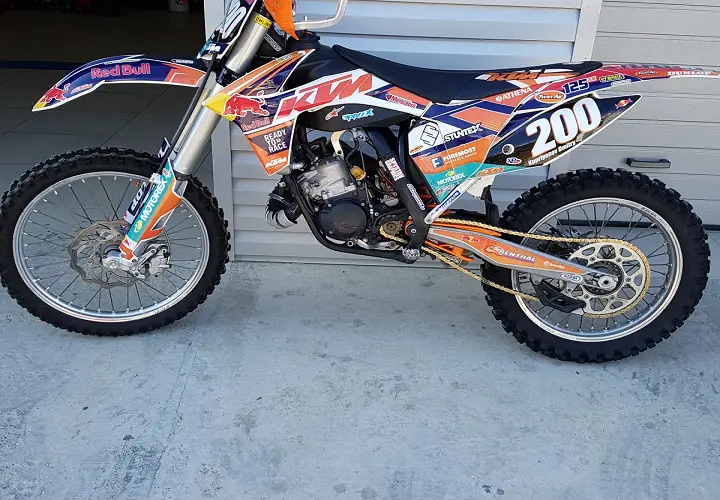
KTM’s 125 SX is renowned for its aggressive power delivery and cutting-edge technology. It’s a favorite among racers looking for a competitive edge and riders who crave peak performance.
Key Features:
- High-performance engine with electronic power valve for broad power band
- Chromoly steel frame offers a balance of flexibility and strength
- Advanced WP XACT suspension for superior comfort and control
- Brembo brakes for top-tier stopping power
Pros:
- Class-leading power output
- Advanced electronics package
- Excellent suspension performance out of the box
Cons:
- Higher price point
- Aggressive power delivery can be intimidating for beginners
Husqvarna TC 125
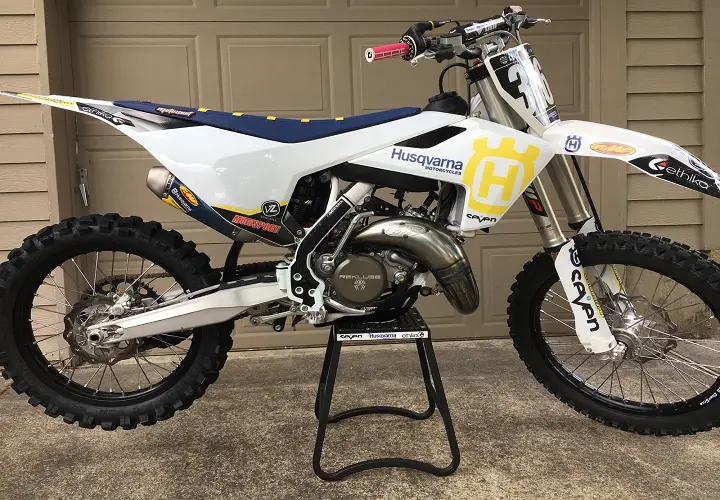
Sharing many components with its KTM cousin, the Husqvarna TC 125 offers a unique blend of Swedish design philosophy and Austrian engineering prowess.
Key Features:
- Distinctive styling sets it apart from the competition
- Premium components throughout, including WP suspension and Brembo brakes
- Excellent ergonomics for rider comfort during long motos
- Composite subframe reduces weight and improves handling characteristics
Pros:
- High-performance engine shared with KTM
- Unique aesthetics appeal to riders looking to stand out
- Slightly more comfortable ergonomics compared to KTM
Cons:
- Premium price tag
- Parts availability can be more limited compared to more common brands
Beta 125 RR
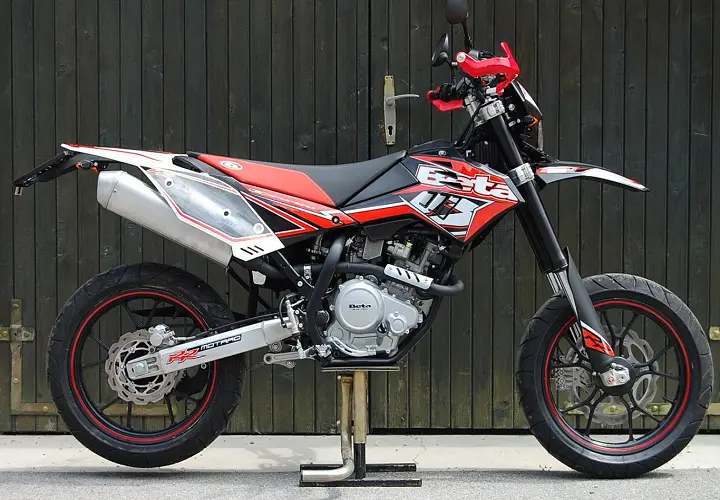
The Beta 125 RR is a relative newcomer to the 125cc dirt bike scene, but it’s making waves with its enduro-focused design and Italian flair.
Key Features:
- Trail-ready from the factory with standard headlight and taillight
- Plush suspension tuned for rough terrain and long rides
- Excellent low-end torque for technical riding and hill climbs
- Unique styling that stands out from Japanese and Austrian competitors
Pros:
- Versatile design works well for both racing and trail riding
- Comfortable ergonomics for long days in the saddle
- Distinctive looks and rarity appeal
Cons:
- Less common brand means fewer dealerships and potentially limited parts availability
- Slightly heavier than some motocross-focused competitors
Maintenance and Care
Proper maintenance is crucial for keeping your 125cc dirt bike in top condition, ensuring longevity, and maximizing performance. Let’s dive into the essential aspects of 125cc dirt bike care:
Essential Maintenance Tasks
- Air Filter Cleaning and Replacement
- Clean after every ride in dusty conditions
- Replace every 5-10 rides, depending on conditions
- Use high-quality filter oil for maximum protection
- Oil Changes
- Change engine oil every 5-10 hours of riding time
- Use manufacturer-recommended oil weight and type
- Don’t forget to change the oil filter regularly
- Chain Maintenance
- Clean and lubricate after each ride
- Adjust tension regularly (typically 30-40mm of play)
- Inspect for wear and replace when necessary
- Tire Pressure Check
- Check before each ride
- Adjust based on terrain (lower for soft, higher for hard)
- Typical range: 12-15 psi, but consult your manual
- Spoke Tension
- Check and adjust monthly
- Ensure even tension across all spokes
- Replace any broken or excessively rusted spokes promptly
- Brake Maintenance
- Inspect brake pads for wear regularly
- Bleed hydraulic brakes annually or as needed
- Adjust cable tension on mechanical brakes
- Suspension Service
- Clean and lubricate linkage bearings every 20 hours
- Change fork oil every 50 hours or annually
- Rebuild shock and fork every 100 hours or as recommended
Frequency of Servicing
Create a maintenance schedule based on your riding frequency:
Weekly (or after each ride):
- Clean the bike thoroughly
- Check tire pressure and condition
- Inspect and lubricate chain
- Clean air filter
- Check all fluid levels
Monthly:
- More in-depth inspection of bearings, cables, and brake pads
- Adjust spoke tension
- Grease all fittings
- Check valve clearance (if applicable)
Annually (or every 50-100 hours):
- Complete overhaul, including top-end rebuild
- Full suspension service
- Replace all fluids
- Inspect and replace worn components (bearings, seals, etc.)
Common Issues and Troubleshooting
Even with diligent maintenance, issues can arise. Here are some common problems and their potential solutions:
- Poor Starting
- Check fuel quality and age
- Clean carburetor (if applicable)
- Inspect spark plug and replace if necessary
- Verify proper valve clearance
- Loss of Power
- Inspect air filter for clogging
- Check for exhaust leaks
- Verify proper fuel mixture (if carbureted)
- Inspect reeds for damage (if two-stroke)
- Suspension Issues
- Look for oil leaks on forks and shock
- Adjust settings for rider weight and style
- Rebuild if performance doesn’t improve with adjustment
- Excessive Noise
- Inspect exhaust system for leaks or damage
- Check engine mounts for tightness
- Verify proper valve clearance
- Inspect chain and sprockets for wear
- Handling Problems
- Check wheel alignment
- Inspect swingarm and linkage bearings
- Verify proper tire pressure and condition
- Adjust suspension settings
Remember, if you’re unsure about any maintenance task or troubleshooting step, it’s always best to consult your owner’s manual or seek the help of a professional mechanic. Proper care will not only keep your 125cc dirt bike running smoothly but also enhance your riding experience and safety.
Riding Techniques for 125cc Dirt Bikes
Mastering the art of riding a 125cc dirt bike requires specific techniques to maximize performance and control. These bikes demand a unique approach due to their lightweight nature and rev-happy engines. Let’s explore the key aspects of riding technique:
Proper Body Positioning
- Stand on the footpegs: Allows for better control and absorption of bumps
- Elbows up: Improves steering control and reduces arm pump
- Head over the handlebars: Enhances front-end traction and cornering
Mastering Cornering
- Approach: Brake before the turn, not during
- Entry: Look through the turn, not at the ground
- Mid-corner: Apply steady throttle to maintain balance
- Exit: Progressively increase throttle as you straighten out
Jumping and Landing Safely
- Take-off: Approach at steady speed, stand up, and pull up on the handlebars
- In-air: Keep the bike level using throttle and body position
- Landing: Absorb impact with legs and arms, land on both wheels simultaneously
Climbing and Descending Hills
Climbing:
- Shift your weight forward
- Maintain steady throttle
- Stand up for better balance
Descending:
- Shift weight to the rear
- Use engine braking and light brake application
- Keep arms and legs bent to absorb bumps
Customizing Your 125cc Dirt Bike
Personalizing your bike can enhance performance and comfort to suit your riding style.
Performance Upgrades
- Exhaust System: Improves power output and reduces weight
- Suspension Tuning: Adjusts for rider weight and riding style
- Gearing Changes: Alters acceleration and top speed characteristics
Aesthetic Modifications
- Graphics Kits: Personalize your bike’s appearance
- Colored Plastics: Change the overall look
- Anodized Parts: Add a touch of flair to functional components
Ergonomic Adjustments for Comfort
- Handlebar Position: Adjust for rider height and preference
- Footpeg Relocation: Can improve leg comfort on long rides
- Seat Foam Modification: Enhances comfort for extended sessions
Safety Gear and Equipment
Proper safety gear is non-negotiable when riding a 125cc dirt bike.
Must-Have Protective Gear
- Helmet: DOT or ECE certified, full-face design
- Goggles: Protect eyes from debris and provide clear vision
- Chest Protector: Guards against impacts and flying debris
- Knee Braces/Guards: Prevent knee injuries during crashes
- Boots: Offer ankle support and protection from hot engine parts
Additional Safety Accessories
- Neck Brace: Reduces risk of cervical spine injuries
- Hydration Pack: Keeps you hydrated during long rides
- First Aid Kit: Essential for trail riding emergencies
Importance of Proper Fit and Quality
Investing in high-quality, well-fitting gear is crucial:
- Ensures maximum protection in case of a crash
- Improves comfort, reducing fatigue during long rides
- Increases durability, saving money in the long run
125cc Dirt Bikes in Competition
The 125cc class remains a vital part of off-road motorcycle racing, showcasing the capabilities of these nimble machines.
Motocross Racing Classes
- Youth Classes: Often the first step for aspiring pro riders
- Amateur Classes: Highly competitive, featuring riders of all ages
- Pro Classes: Still featured in some national and international series
Enduro and Trail Riding Events
125cc bikes excel in endurance-focused events:
- Hare Scrambles: Fast-paced races through natural terrain
- Enduros: Long-distance events testing rider and machine endurance
- Trail Rides: Non-competitive events exploring off-road trails
Notable Professional Riders Who Started on 125cc Bikes
Many top riders cut their teeth on 125cc dirt bikes:
- Ricky Carmichael: “The GOAT” began his pro career on a 125
- James Stewart: Known for his incredible speed on 125cc bikes
- Ken Roczen: European champion in the 125cc class before moving to the US
Environmental Impact and Responsible Riding
As off-road enthusiasts, it’s our duty to minimize our impact on the environment.
Noise Reduction Techniques
- Install a high-quality aftermarket exhaust with spark arrestor
- Maintain proper engine tuning to reduce unnecessary noise
- Avoid revving the engine excessively, especially in sensitive areas
Minimizing Trail Damage
- Stay on designated trails and tracks
- Avoid riding during wet conditions when trails are most vulnerable
- Practice proper cornering techniques to reduce soil erosion
Eco-Friendly Riding Practices
- Use biodegradable chain lube and cleaning products
- Dispose of used oil and fluids properly
- Support trail maintenance and conservation efforts in your area
The Future of 125cc Dirt Bikes
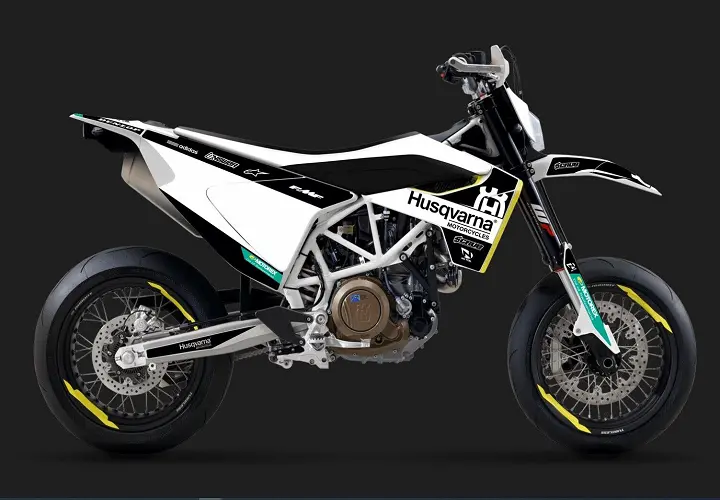
The 125cc dirt bike class continues to evolve, embracing new technologies and trends.
Emerging Technologies
- Electronic Fuel Injection: Becoming standard, improving fuel efficiency and power delivery
- Traction Control: Enhancing rider control in various conditions
- Lightweight Materials: Ongoing development of carbon fiber and titanium components
Electric 125cc Equivalents
Electric motorcycles are making inroads in the off-road world:
- KTM Freeride E-XC: Offers performance comparable to a 125cc gas bike
- Sur-Ron Light Bee: Popular for its lightweight design and silent operation
- Stark Varg: High-performance electric motocross bike challenging traditional perceptions
Predictions for the Next Generation of Bikes
- Hybrid Power Systems: Combining electric and gas power for extended range
- Advanced Suspension: Self-adjusting systems that adapt to terrain in real-time
- Integrated Connectivity: GPS navigation and performance tracking built into the bike
Conclusion
The 125cc dirt bike remains a cornerstone of off-road motorcycling, offering an unmatched combination of agility, performance, and accessibility.
From beginners taking their first off-road ride to professionals pushing the limits of what’s possible on two wheels, these bikes continue to inspire and challenge riders of all levels.
As we look to the future, 125cc dirt bikes will undoubtedly evolve, embracing new technologies while maintaining the core attributes that make them so beloved.
Whether you’re racing, trail riding, or simply enjoying the thrill of off-road freedom, a 125cc dirt bike offers an experience that’s hard to beat.
So, gear up, hit the trails, and discover the exhilarating world of 125cc dirt bikes for yourself. The adventure awaits!

With over 9 years of dedicated experience in the automotive industry, I am passionate about all things automotive. My journey began with a deep curiosity for automobiles, which led me to delve deeper into their mechanics, technology and trends. My expertise spans various aspects of the automotive world, from the latest electric vehicles to classic car restoration techniques. Through my articles, I aim to share my knowledge and insights, helping readers stay informed and inspired in the fast-paced world of the automobile.
